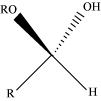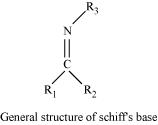A:
(i) Cyanohydrin:
Cyanohydrins are organic compounds having the formula RR“²C(OH)CN, where R and R“² can be alkyl or aryl groups.

Aldehydes and ketones react with hydrogen cyanide (HCN) in the presence of excess sodium cyanide (NaCN) as a catalyst to field cyanohydrin. These reactions are known as cyanohydrin reactions.

Cyanohydrins are useful synthetic intermediates.
(ii) Acetal:
Acetals are gem - dialkoxy alkanes in which two alkoxy groups are present on the terminal carbon atom. One bond is connected to an alkyl group while the other is connected to a hydrogen atom.

When aldehydes are treated with two equivalents of a monohydric alcohol in the presence of dry HCl gas, hemiacetals are produced that further react with one more molecule of alcohol to yield acetal.

(iii) Semicarbarbazone:
Semicarbazones are derivatives of aldehydes and ketones produced by the condensation reaction between a ketone or aldehyde and semicarbazide.

Aldehydes and ketones react with hydrogen cyanide (HCN) in the presence of excess sodium cyanide (NaCN) a a catalyst to field cyanohydrin. these reactions are called cyanohydrin reactions. These are useful synthetic intermediates. Semicarbazones are useful for identification and characterization of aldehydes and ketones.
(iv) Aldol:
A Ã�²–hydroxy aldehyde or ketone is known as an aldol. It is produced by the condensation reaction of two molecules of the same or one molecule each of two different aldehydes or ketones in the presence of a base.

(v) Hemiacetal:
Hemiacetals are α - alkoxyalcohols

General structure of a hemiacetal
Aldehyde reacts with one molecule of a monohydric alcohol in the presence of dry HCl gas.

(vi) Oxime:
Oximes are a class of organic compounds having the general formula RR“²CNOH, where R is an organic side chain and R“² is either hydrogen or an organic side chain. If R“² is H, then it is known as aldoxime and if R“² is an organic side chain, it is known as ketoxime.

On treatment with hydroxylamine in a weakly acidic medium, aldehydes or ketones form oximes.

(vii) Ketal:
Ketals are gem - dialkoxyalkanes in which two alkoxy groups are present on the same carbon atom within the chain. The other two bonds of the carbon atom are connected to two alkyl groups.

Ketones react with ethylene glycol in the presence of dry HCl gas to give a cyclic product known as ethylene glycol ketals.

(viii) Imine:
Imines are chemical compounds containing a carbon nitrogen double bond.

Imines are produced when aldehydes and ketones react with ammonia and its derivatives.

(ix) 2, 4 - DNP - derivative:
2, 4 - dinitrophenylhydragones are 2, 4 - DNP - derivatives, which are produced when aldehydes or ketones react with 2, 4 - dinitrophenylhydrazine in a weakly acidic medium.

To identify and characterize aldehydes and ketones, 2, 4 - DNP derivatives are used.
(x) Schiff's base:
Schiff's base (or azomethine) is a chemical compound containing a carbon-nitrogen double bond with the nitrogen atom connected to an aryl or alkyl group-but not hydrogen. They have the general formula R1R2C = NR3. Hence, it is an imine.
It is named after a scientist, Hugo Schiff.

Aldehydes and ketones on treatment with primary aliphatic or aromatic amines in the presence of trace of an acid yields a Schiff's base.


























 (iv)
(iv) 





















































































 (vi) PhCOPh
(vi) PhCOPh























